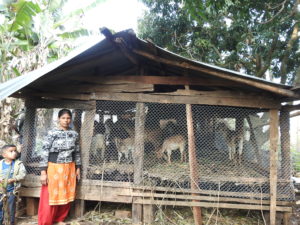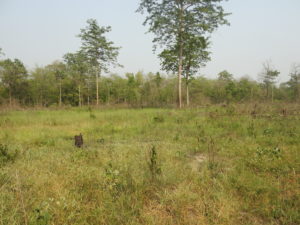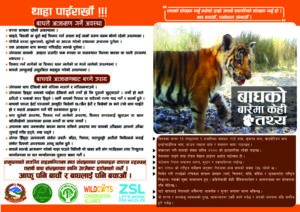ZSL Nepal has supported the Government’s ongoing investment in Parsa National Park (PNP), facilitating the additional of 129 km2 in 2015 (PNPea) and subsequently its upgrade to a national park in 2017. This project focuses on PNPea. Past projects have improved tiger security and habitat through stringent law enforcement, bio-monitoring and connectivity. These have contributed to a near three-fold increase in tiger population since 2013 and recovery of other wildlife.
This project addresses potential future escalation of Human Tiger Conflict (HTC) and improves tiger’s access to high-quality habitat and resources within the core area of the park. It is reducing access to livestock and decreasing the relative attraction for wildlife to enter human settlements whilst at the same time, fostering community support for tiger conservation.
Participatory Approaches to Corridor Coexistence with Tigers (PACCT), addresses HTC to reduce buffer zone community’s costs from living alongside tigers in terms of livestock predation and the risk of attacks on people.
ZSL conducted stakeholder and community meetings in four forest-dependent communities for 108 participants to introduce PAACT and HTC relief schemes. During these meetings, the community themselves chose 30 most HTC vulnerable households who could be supported to build predator-proof corrals to deter large carnivores.
Four participatory habitat management workshops conducted in the project site sensitised nearly 200 community members on the importance of tiger and its ecosystem, tiger conservation and its long-term benefits and HTC including relief mechanism. Through the distribution of leaflets, more than 2,200 people have been reached.
Similarly, key habitat (grassland and wetland) management inside the core area of the park has aided in the recovery of prey species, thereby sustaining the increasing tiger number.
Summary of the 2019 report:
- Three meetings were held with stakeholders and community to identify 30 HTC vulnerable households and introduce PACCT and HTC relief. Altogether, 108 community members took part in three interaction programs out of which 50 were female.
- 30 predator-proof corrals were built using local materials, for vulnerable forest dependent households via partnerships between ZSL, the community and Community Forest Users Groups (CFUGs), where ZSL provided majority support.
- Nearly 800 leaflets giving information on tiger and its habitat conservation, conservation laws regarding tiger, HTC mitigation measure, etc. were distributed during different workshops/interactions with community people.
- Four community habitat management workshops were held, attended by 185 community members of which 83 were women.
- 20 ha of grasslands, and the Halkhoriya lake, a key waterhole in PNPea, have improved habitat quality resulting from management through community engagement and ownership.
- No occurrence of HTC happened in the PNPea during this project period.
- A total of 2,200 community members have increased ability to access existing human-tiger conflict relief funds.

Predator proof corral © ZSL Nepal

Tiger workshop in Aadahavar Parsa © ZSL Nepal

Grassland Management near Chittal Pokhari, Parsa © ZSL Nepal


